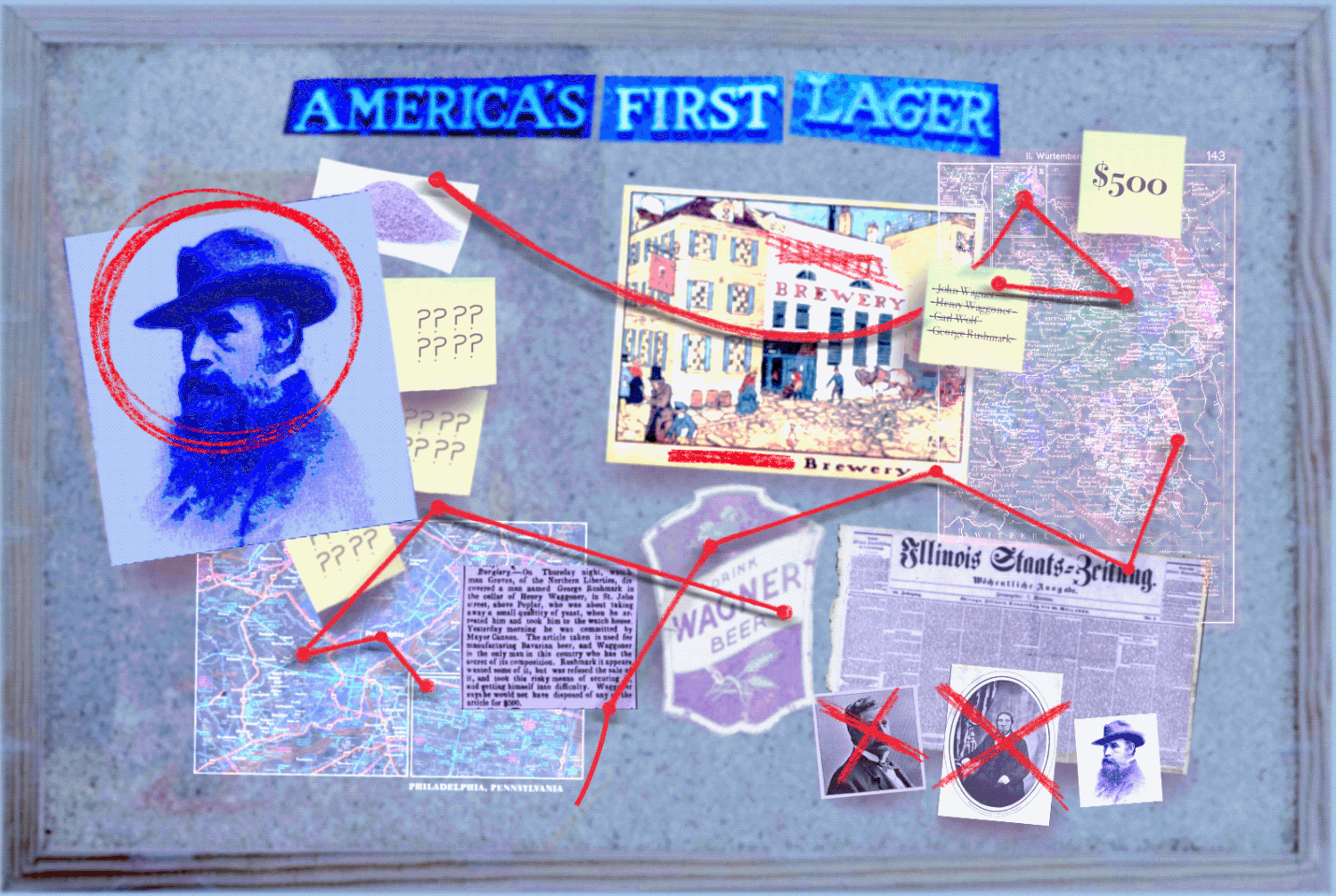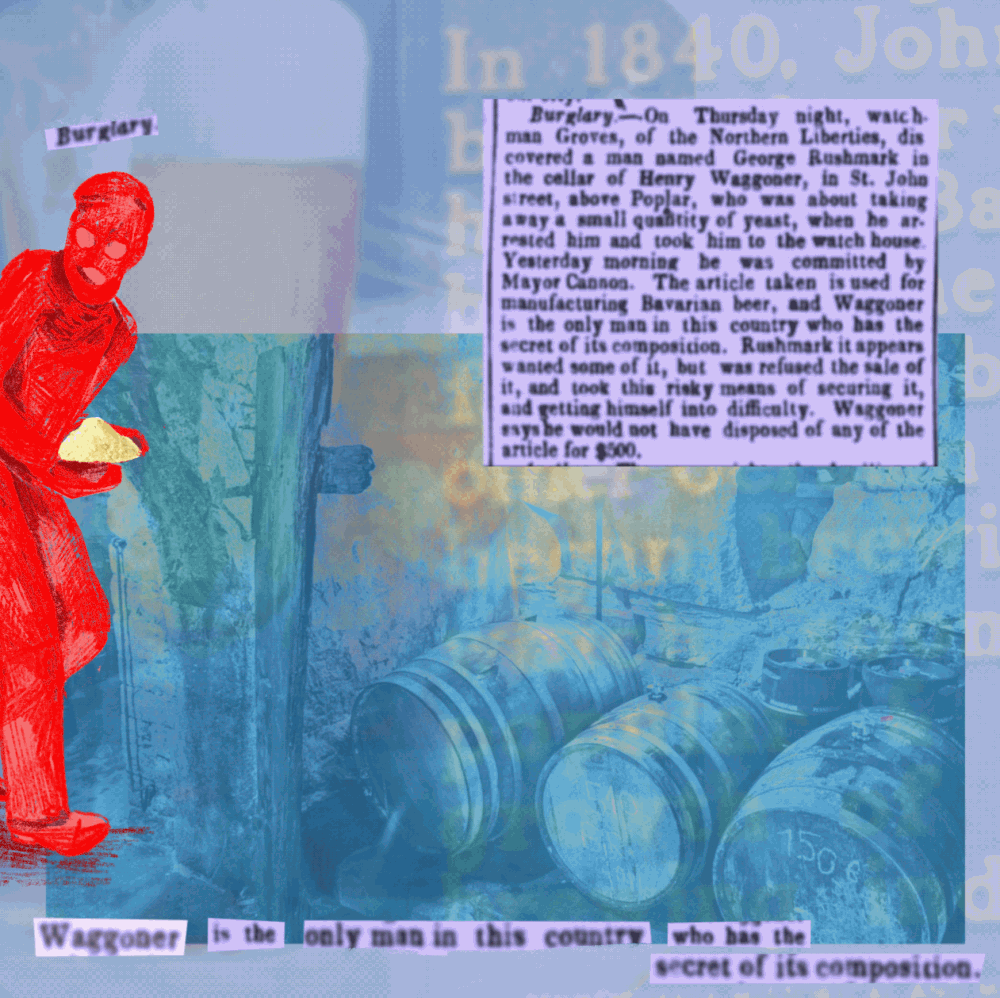
In front of a redbrick 1920s townhouse on a quiet, narrow street in Philadelphia’s Northern Liberties neighborhood, a cast-iron plaque stands in honor of “America’s First Lager Beer.” The memorial claims to mark the spot where, in 1840, a Bavarian immigrant by the name of John Wagner opened a brewery to make beer using bottom-fermenting yeast that he had brought from his homeland some 4,000 miles away. Since the start of the 20th century, the story of “John Wagner, American Lager-brewing pioneer,” has been repeated countless times in books and newspaper and magazine articles. It remains one of American beer drinkers’ most-loved tales.

The crowd who gathered on a sunny December Saturday in 2001 for the unveiling of the plaque at the corner of American and Poplar Streets had no reason to doubt the truth of the story they were celebrating. A four-year campaign had finally persuaded the Pennsylvania Historical and Museum Commission to place one of its blue markers on the site of what was said to be the first Lager brewery in the United States. There was solid-looking evidence dating back more than a hundred years from a contemporary witness who confirmed John Wagner’s vital role in introducing Lager brewing to America, backed up by at least two other accounts from the 19th century. Speeches were made. A poem was recited. This was the first official recognition of Philadelphia’s undoubtedly important role in the growth of the American beer industry, and everybody involved could feel proud.
Unfortunately, the story isn’t true. There is no evidence that a brewer named John Wagner ever existed, nor that Lager was first brewed in the United States in 1840. One of American beer drinkers’ most-loved tales is a myth.
While Lager brewing in America did start in Philadelphia in the 1840s, the true story is odder, darker, and more mysterious than the one that’s been widely shared. It involves an unsuccessful burglary, a different man named Wagner, a two-year spell in the penitentiary, and a much-loved but now almost forgotten character called Fat George.
TRUTHS AND CONSEQUENCES
There have been doubts cast on the John Wagner myth before. Gregg Smith, author of “Beer in America: The Early Years,” was perceptive enough to say in 1998 that the story “may not be correct.” Tod von Mechow, a historian of beer bottlers, found the story of the break-in at “Henry Waggoner’s” in 2017, but could not quite bring himself to say that the story of John Wagner as Philadelphia’s first Lager brewer was wrong.
The “John Wagner, Lager pioneer” myth springs from the reminiscences of Carl Wolf, a Philadelphia brewer whose words were taken down some 50 years after the events he described. Born in Germany in 1812, Wolf was at least 90 when he was interviewed about the early years of Lager brewing in Philadelphia, and he looks to have gotten two facts wrong: the name of the man who brought Lager yeast to the United States and the year he did it.
The ‘John Wagner, Lager pioneer’ myth springs from the reminiscences of Carl Wolf, a Philadelphia brewer whose words were taken down some 50 years after the events he described.
Wolf—who was also the father of Otto Wolf, one of the leading brewery architects in the country—died in 1897. Before he died, his recollections were recorded and printed in “100 Years of Brewing,” a massive and influential survey of the American beer industry that was published in 1903.
In that book, Wolf is recorded as saying that the man with the first Lager yeast in the U.S. was John Wagner, who had been a brewmaster in Bavaria. Wagner had started brewing with Lager yeast at his house on Philadelphia’s St. John Street in 1840, he added, with a primitive setup involving a kettle holding just eight barrels—implying a vessel smaller than four feet wide and three feet high—suspended over an open hearth.
However, there is no historical record of a John Wagner living on St. John Street in the relevant years, nor any John Wagner in Philadelphia who would be a likely candidate for the first American Lager brewer. It looks as if Wolf misremembered both the date and the name, which is a worthy reminder: Just because it’s in an old book doesn’t mean it’s correct.
In fact, the arrival of Lager brewing in America was first announced, bizarrely, by a break-in at a house on the outskirts of Philadelphia. In November 1842, the Public Ledger newspaper reported that a night watchman in Northern Liberties discovered a man named George Rushmark in the cellar of Henry “Waggoner” in St. John Street. He was caught in the act of stealing a small quantity of yeast.
The yeast, the newspaper said, “is used for manufacturing Bavarian beer, and Waggoner is the only man in this country who has the secret of its composition. Rushmark, it appears, wanted some of it, but was refused the sale of it, and took this risky means of securing it, and getting himself into difficulty. Waggoner says he would not have disposed of any of the article for $500.”
Henry Wagner—or “Waggoner,” as the Public Ledger misidentified him—looks to have arrived in Philadelphia two years earlier, in November 1840, according to immigration records. He came on board the brig Stern, after having sailed 4,300 miles from Bremen, north Germany. Wagner was 18, and made the voyage with his older brothers, one of whom, Charles, was a cooper.
The yeast that Rushmark—a 27-year-old, Bavarian-born cabinet-maker—was trying to steal was clearly the bottom-fermenting variety that Bavarian brewers had been using to make “Lager” beer from, from about 1485 onwards. The man whose cellar he was trying to steal it from is listed in the 1842 edition of “M’Elroy’s Philadelphia Directory” as a cooper living at 283 St. John Street. One source says that Rushmark was actually Wagner’s brother-in-law. At any rate, the would-be yeast thief was found guilty of burglary by the General Sessions in Philadelphia and given a two-year jail sentence in the city’s Eastern State Penitentiary.
STOCK YEAST AND COMMON PROPERTY
The attempted theft at Henry Wagner’s house is the first confirmable mention of Lager yeast in the United States. Wagner seems to have disappeared, or stopped working as a cooper, soon after the burglary: The 1843 edition of “M’Elroy’s Philadelphia Directory” lists two Henry Wagners, one a victualler in Weaver’s Court and one a furniture carpenter at 302 St. John Street. But the story that it was Wagner who introduced brewing with Lager yeast in 1842 was backed up by a witness, Frederick Lauer.

At the time, Lauer was running a small Ale and Porter brewery 50 miles from Philadelphia in Reading, Pennsylvania, that had been started by his father George. Lauer, who eventually became president of the United States Brewers’ Association, and who was a revered figure in the industry, was quoted saying “a German named Wagner” had introduced “the ‘stock yeast’ used in the manufacture of Lager in Bavaria” in Philadelphia in 1842.
In 1878, Lauer told the Cincinnati Enquirer that he had attempted to purchase some of Wagner’s yeast. He was quoted in the peculiar “eye dialect” that 19th-century newspapers sometimes used for people with German accents, though Lauer had been 12 years old when he arrived in the United States with his family in 1823, and may well have lost his accent after 55 years:
“There was a man from Chermany come over to tis country in 1842. He had some stock yeast. He began to sell that Lager peer [sic] up in the Northern Liberties of Philadelphia. It attracted great attention. I went up there and tasted it and tried to buy some of that stock yeast. He wouldn’t sell it. But a tishonest prewer [sic] broke into his cellar and stole some of that yeast. It got out and was common property.”
Lauer appears to be using “stock” as a literal translation of the German word “Lager,” and “stock yeast” would be the English equivalent of the German phrase “Lager Bierhefe.”
THE PATRIARCH OF BREWERS
According to Carl Wolf, some of Wagner’s yeast was given to George Manger, a practical brewer who was working for Wolf’s sugar-refining business in Philadelphia at the time. Manger then “started a brewery on a somewhat larger scale in New Street, near Second.”
This again appears to be a slight misremembering. The Philadelphia Directory for 1845, which would probably have been compiled in 1844, shows Charles Psotta, born Johann Carl Psotta in Germany in 1816, as a brewer at 56 New Street. In the 1846 directory, J.G. Manger—aka George Manger—was listed as running a tavern at 56 New Street, and in 1847, Manger and Psotta are both listed as brewers at “56 New.”
‘There was a man from Chermany come over to tis country in 1842. He had some stock yeast. He began to sell that Lager peer [sic] up in the Northern Liberties of Philadelphia. It attracted great attention. I went up there and tasted it and tried to buy some of that stock yeast. He wouldn’t sell it. But a tishonest prewer [sic] broke into his cellar and stole some of that yeast. It got out and was common property.’
Two years later, in April 1849, the Reliance Engine Company, one of Philadelphia’s insurance company-owned private fire departments, ran a notice in The Public Ledger giving “sincere thanks” to “Messrs Manger & Psotta, No 62 [sic] New st, for the bountiful supply of Refreshments furnished by them on the day of the Triennial Parade of the Fire Department.”
It was Manger, “der dicke Georg,” meaning “Fat” or “Big” George, who was originally given the earliest credit for brewing Lager in the city. A guidebook from 1857 agrees that “Lager Beer was first introduced into Philadelphia in 1840 [sic], by a Mr Wagner,” but says that Wagner “afterwards left the city.” Instead, it declared: “The first who made the real Lager was Geo Manger, better known as Big George, who in October 1844 had a small kettle in one corner of the premises still occupied by him in New Street above Second.”
Writing about his youth in Philadelphia in his book “Memoirs” in 1893, the writer Charles Godfrey Leland agreed on the identity of the first brewer of Bavarian-style beer, though he dated that ur-bier slightly later: “Lager beer was not as yet in the land. I remember drinking it in after years in New Street, where a German known as der dicke Georg first dealt it in 1848 to our American public.”
A quarter of a century later, the book “History of Philadelphia 1609-1884” made a similar claim: “Philadelphia was the first place in this country where Lager beer was made, and the original brewer was George Manger, who had a brewery about 1846-47, on New Street […] the first place at which this beer was sold was in Dillwyn Street, below Callowhill, and probably not earlier than 1847.” The reference to Dillwyn Street appears to be to Carl Wolf and Charles Engel, who were advertising in The Public Ledger in December 1847 that “a good supply of their Lager or Bavarian Beer, put up in Small Bottles or Casks,” was available from the Engel and Wolf premises at 26 and 28 Delwyn Street.
After Manger’s partnership with Psotta broke up in 1850, “Fat George” took another partner at the New Street brewery, Bavarian immigrant Peter Schemm. Schemm left the New Street brewery in 1856, and Manger carried on alone. Manger died aged 64 in Philadelphia in August 1863, his death notices crediting him as “the first individual who brewed Lager beer in that city.” The Illinois Staats-Zeitung, a German-language newspaper in Chicago, called him “Der Patriarch der Philadelphier Lagerbierbrauer,” or “the patriarch of Philadelphia’s Lager beer brewers.” According to the Staats-Zeitung, Manger was “the founder of the now-enormous lager beer industry in that place,” and “was known far and wide under the name Fat George,” and “everyone loved him because of his honesty and kindness.”
QUESTIONS WITHOUT ANSWERS
The facts as we know them still leave several questions unanswered. Henry Wagner, not “John Wagner,” looks to be the person who brought bottom-fermenting yeast to the United States. But how did Henry successfully get that yeast from, presumably, Bavaria in the south of Germany to Philadelphia, via Bremen in northern Germany? Was Henry brewing commercially? He appears not to have been, or at least there is no record of him doing so, and the newspaper account of the attempted theft of yeast at his house does not mention commercial brewing by Henry.
A guidebook from 1857 agrees that ‘Lager Beer was first introduced into Philadelphia in 1840 [sic], by a Mr Wagner,’ but says that Wagner ‘afterwards left the city.’ Instead, it declared: ‘The first who made the real Lager was Geo Manger, better known as Big George, who in October 1844 had a small kettle in one corner of the premises still occupied by him in New Street above Second.’
How then did Fat George get hold of Henry’s yeast, when Henry, who clearly recognized the commercial potential of what he had, told the newspaper he would not accept even $500—equivalent to $250,000 today—for it? And why did poor Fat George Manger, the true pioneer of commercial Lager brewing in the United States, get left out of the story, when upon his death he was hailed as “Der Patriarch der Philadelphier Lagerbierbrauer”? Was Wolf playing down the achievements of his former employee and later Lager-brewing rival?

However the first Lager yeast came to America, and whoever it was that brought it, the rise of Lager, once it arrived, was swift, at least in Pennsylvania. In 1849, Pittsburgh’s Daily Morning Post could still describe “Bavarian Beer” as “a comparatively new article on the market.” It was priced at $6, presumably a barrel, against $6 for Common Ale (the warm-fermented “everyday brew” of the time), $7 for the stronger XX Ale, and $8 for the strongest XXX, suggesting that Lager was competing directly for the ordinary beer drinker’s thirsts. In 1850, another Pennsylvania newspaper reported that in Cincinnati, “two German gentlemen, who are heavy capitalists, have purchased a large lot on Jackson Street, on which they intend to erect a brewery. Most probably this is for the brewing of their celebrated Lager Beer, which has now such an unprecedented popularity in Philadelphia.”
The triumph of Lager took barely half a generation. As a correspondent from Philadelphia wrote in the Democrat and Sentinel newspaper in 1855, just 13 years after George Rushmark had tried to steal Henry Wagner’s yeast:
“Lager bier has become one of the best established institutions of our city. Numberless saloons have been established, all of which appear to be doing a good business. The love of Lager not only enchains the souls of our German population, but the citizens generally, and it is with very many of our citizens a favorite beverage. In a number of rooms it is vended in enormous quantities nightly in conjunction with sometimes a little good, a good deal indifferent, and much bad music, a species of combined enjoyment appropriately styled Lager Bier Opera.”

